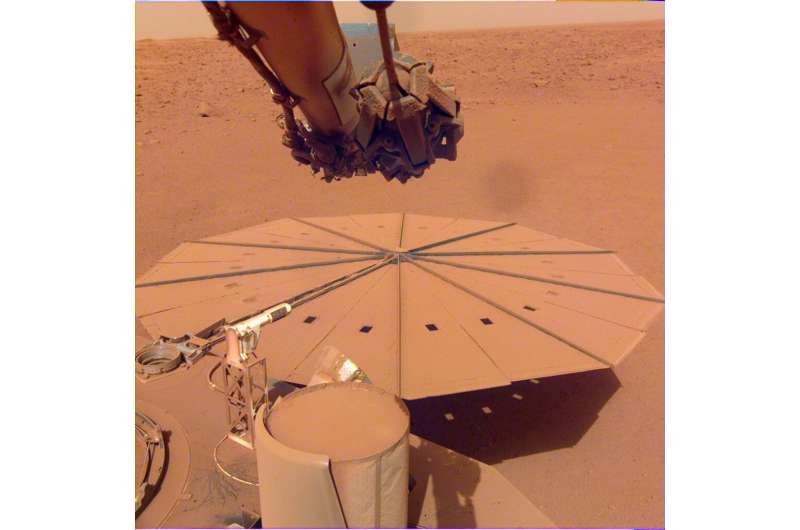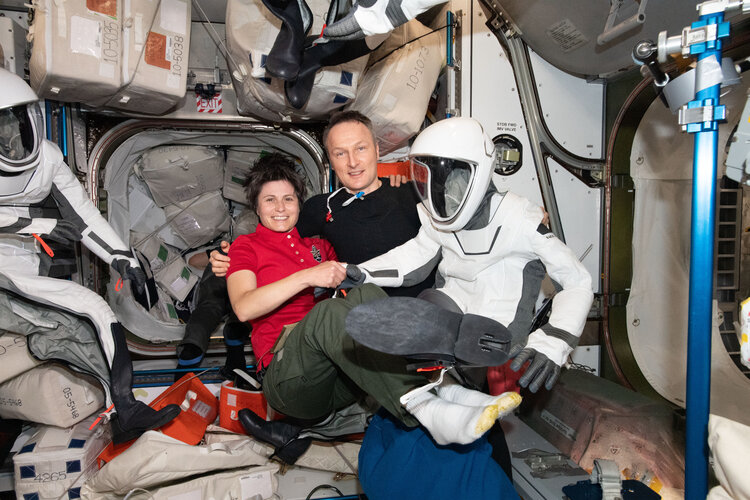
Copernical Team
Solar heat likely the primary cause of dust storms on Mars
 A team of scientists, including Dr. German Martinez from the Universities Space Research Association at LPI, just published a study in the Proceedings of the National Academy of Sciences. This study indicates there are seasonal energy imbalances in the amount of solar energy absorbed and released by Mars which is a likely cause of dust storms, and could play an important role in understanding th
A team of scientists, including Dr. German Martinez from the Universities Space Research Association at LPI, just published a study in the Proceedings of the National Academy of Sciences. This study indicates there are seasonal energy imbalances in the amount of solar energy absorbed and released by Mars which is a likely cause of dust storms, and could play an important role in understanding th NASA's InSight still hunting marsquakes as power levels diminish

Dusty solar panels and darker skies are expected to bring the Mars lander mission to a close around the end of this year.
NASA's InSight Mars lander is gradually losing power and is anticipated to end science operations later this summer. By December, InSight's team expects the lander to have become inoperative, concluding a mission that has thus far detected more than 1,300 marsquakes—most recently, a magnitude 5 that occurred on May 4—and located quake-prone regions of the Red Planet.
The information gathered from those quakes has allowed scientists to measure the depth and composition of Mars' crust, mantle, and core. Additionally, InSight (short for Interior Exploration using Seismic Investigations, Geodesy and Heat Transport) has recorded invaluable weather data and studied remnants of Mars' ancient magnetic field.
NASA's InSight lander: The lonely fate of a robot on Mars

Covered in the red dust that sealed its fate, the NASA InSight lander is slowly shutting down, more than 250 million kilometers from home.
With its solar panels now obscured by the red planet's debris, the four-year-old robot is running out of power. One by one, its instruments are being taken offline: its robotic arm moving into "retirement pose," its seismometer likely to be turned off sometime in June.
Dr. Catherine Johnson, co-investigator on the InSight science team and professor in the department of earth, ocean and atmospheric sciences, discusses what the team discovered, what questions are left to answer, and just what will happen to the little lander that could.
What was the lander's mission and what did it find?
April in orbit: two ESA astronauts and plenty of science

April 2022 was an exciting month for Europe in space. After a few weather-related delays, ESA astronaut Samantha Cristoforetti was launched to the International Space Station on 27 April with Crew-4 for her second mission, Minerva. She was welcomed aboard the International Space Station by Matthias Maurer, marking the first time since 2011 that two ESA astronauts had been together in orbit. Look back on another busy month aboard the orbital outpost in this regular summary from the International Space Station.
Landmark partnership between the US and UK to launch new era of spaceflight
 Future spaceflight will be made easier and cheaper, following a landmark partnership with the United States to help cut red tape and boost opportunities in the UK, signed by the Transport Secretary this week in Washington.
Transport Secretary Grant Shapps and US Transportation Secretary Pete Buttigieg signed a declaration on 11 May 2022 to work together on future commercial spaceflight mis
Future spaceflight will be made easier and cheaper, following a landmark partnership with the United States to help cut red tape and boost opportunities in the UK, signed by the Transport Secretary this week in Washington.
Transport Secretary Grant Shapps and US Transportation Secretary Pete Buttigieg signed a declaration on 11 May 2022 to work together on future commercial spaceflight mis 4D composite printing can improve the wings of drones
 The aviation industry faces multiple pressures from higher fuel costs and increased scrutiny over the environmental and quality-of-life impacts from its aircraft. Researchers are looking for new methods of keeping expenses down while improving overall efficiency, and the relatively new market of unmanned aerial vehicles (UAVs) - or drones - is no exception.
UAVs are occupying an ever-growi
The aviation industry faces multiple pressures from higher fuel costs and increased scrutiny over the environmental and quality-of-life impacts from its aircraft. Researchers are looking for new methods of keeping expenses down while improving overall efficiency, and the relatively new market of unmanned aerial vehicles (UAVs) - or drones - is no exception.
UAVs are occupying an ever-growi OneWeb and Telefonica collaborate to extend connectivity across Europe and Latin America
 OneWeb, the low Earth orbit satellite communications company, and Telefonica through, Telefonica Global Solutions (TGS), the subsidiary of global telecommunications company Telefonica that manages the international Wholesale, Global Roaming, Multinationals and USA businesses, have signed a Memorandum of Understanding (MoU) to improve connectivity services across Europe and Latin America. The col
OneWeb, the low Earth orbit satellite communications company, and Telefonica through, Telefonica Global Solutions (TGS), the subsidiary of global telecommunications company Telefonica that manages the international Wholesale, Global Roaming, Multinationals and USA businesses, have signed a Memorandum of Understanding (MoU) to improve connectivity services across Europe and Latin America. The col Next Stop: Hawksbill Gap
 Perseverance was on the move this past week after finishing up remote science activities at Enchanted Lake, an exposure of finely layered rocks that may represent some of the lowest deposits of the delta. The rover threaded its way east around large sandy dune ripples before heading north enroute to Hawksbill Gap, where the team hopes to collect our first set of delta samples and eventually asce
Perseverance was on the move this past week after finishing up remote science activities at Enchanted Lake, an exposure of finely layered rocks that may represent some of the lowest deposits of the delta. The rover threaded its way east around large sandy dune ripples before heading north enroute to Hawksbill Gap, where the team hopes to collect our first set of delta samples and eventually asce EUSPA celebrates its first 365 days of new Galileo operations
 The EU Agency for the Space Program celebrates its first anniversary with new services, a new satellite and even more end users.
Time flies when you're busy getting things done. And in the first year of its existence, the EU Agency for the Space Program (EUSPA) has gotten a lot of things done.
"EUSPA's launch one year ago today represented the start of a new era for the EU Space Prog
The EU Agency for the Space Program celebrates its first anniversary with new services, a new satellite and even more end users.
Time flies when you're busy getting things done. And in the first year of its existence, the EU Agency for the Space Program (EUSPA) has gotten a lot of things done.
"EUSPA's launch one year ago today represented the start of a new era for the EU Space Prog Momentus "Go for Launch" for First Vigoride Mission
 Momentus Inc. (NASDAQ: MNTS), a U.S. commercial space company that plans to offer transportation and other in-space infrastructure services, has announced that it has completed the integration of its Vigoride Orbital Transfer Vehicle and customer payloads on the SpaceX Falcon 9 launch vehicle that will be used for the Transporter-5 mission targeted for launch this month.
Momentus recently
Momentus Inc. (NASDAQ: MNTS), a U.S. commercial space company that plans to offer transportation and other in-space infrastructure services, has announced that it has completed the integration of its Vigoride Orbital Transfer Vehicle and customer payloads on the SpaceX Falcon 9 launch vehicle that will be used for the Transporter-5 mission targeted for launch this month.
Momentus recently 